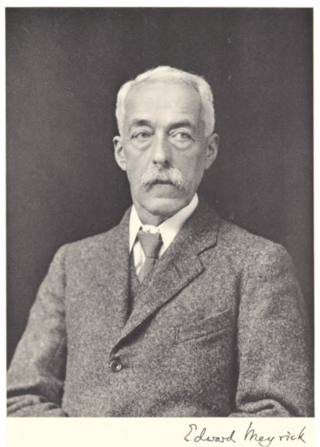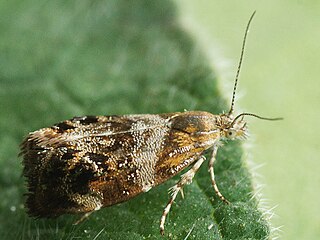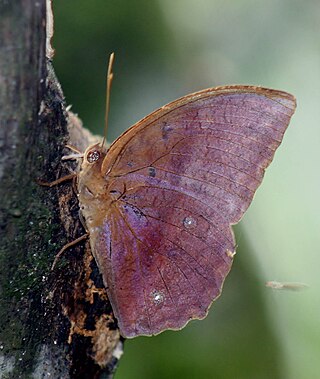
Edward Meyrick was an English schoolmaster and amateur entomologist. He was an expert on microlepidoptera and some consider him one of the founders of modern microlepidoptera systematics.

Heliothis is a genus of moths in the family Noctuidae. It was first described by Ferdinand Ochsenheimer in 1816. Some of the species have larvae which are agricultural pests on crop species such as tobacco, cotton, soybean and pigeon pea. Some species originally in this genus have been moved to other genera, see Chloridea and Helicoverpa.

Discophora timora, the great duffer, is a butterfly found in South Asia that belongs to the Morphinae subfamily of the brush-footed butterflies family.

Enispa is a genus of moths of the family Erebidae. The genus was erected by Francis Walker in 1866.

Timora is a genus of moths of the family Noctuidae. Some authors consider it to be a subgenus of Heliothis.

Marumba is a genus of moths in the family Sphingidae first described by Frederic Moore in 1882.

Tytroca metaxantha is a moth of the family Erebidae first described by George Hampson in 1902. It is found in South Africa and Zimbabwe.

Micragrotis interstriata is a species of moth of the family Noctuidae first described by George Hampson in 1902. It is found in Africa, including Zimbabwe and South Africa.
Heliothis galatheae is a species of moth of the family Noctuidae first described by Hans Daniel Johan Wallengren in 1856. It is found all over Africa, including South Africa to Ethiopia and the Gambia.

Heliothinae is a small, cosmopolitan subfamily of moths in the family Noctuidae, with about 400 described species worldwide. It includes a number of economically significant agricultural pest species, such as Helicoverpa armigera and Helicoverpa zea.
Heliothis transvaalica is a species of moth of the family Noctuidae first described by William Lucas Distant in 1902. It is found in Transvaal of South Africa and in Namibia.
Timora albisticta is a species of moth of the family Noctuidae first described by Anthonie Johannes Theodorus Janse in 1917. It is found in Africa, including in South Africa.
Timora diarhoda is a species of moth of the family Noctuidae first described by George Hampson in 1909. It is found in Africa, including South Africa.
The Micronoctuini are a tribe of moths in the family Erebidae that includes about 400 described species. Typical species in the tribe have bifine hindwing venation and are smaller than those in other noctuoid moths. Micronoctua karsholti is the smallest of all species in the superfamily Noctuoidea.
Louis Beethoven Prout (1864–1943) was an English entomologist and musicologist.

Tebenna bjerkandrella is a moth of the family Choreutidae first described by Carl Peter Thunberg in 1784. It is found from Europe, Morocco, Madeira and the Canary Islands through central Asia to Japan. It has also been recorded from South Africa.

Ariadne is a genus of nymphalid butterflies, commonly called castors, found from Sub-Saharan Africa to South-East Asia. It was erected by Thomas Horsfield in 1829. The genus was named after Ariadne the daughter of Minos, king of Crete.

Discophora, commonly known as the duffers is a genus of butterflies in the family Nymphalidae. The members are confined to India, China and Southeast Asia.
Gumilevia is a genus of moths in the family Cossidae.
Gumilevia timora is a moth in the family Cossidae. It was described by Yakovlev in 2011. It is found in Equatorial Guinea (Bioko).
This page is based on this
Wikipedia article Text is available under the
CC BY-SA 4.0 license; additional terms may apply.
Images, videos and audio are available under their respective licenses.










